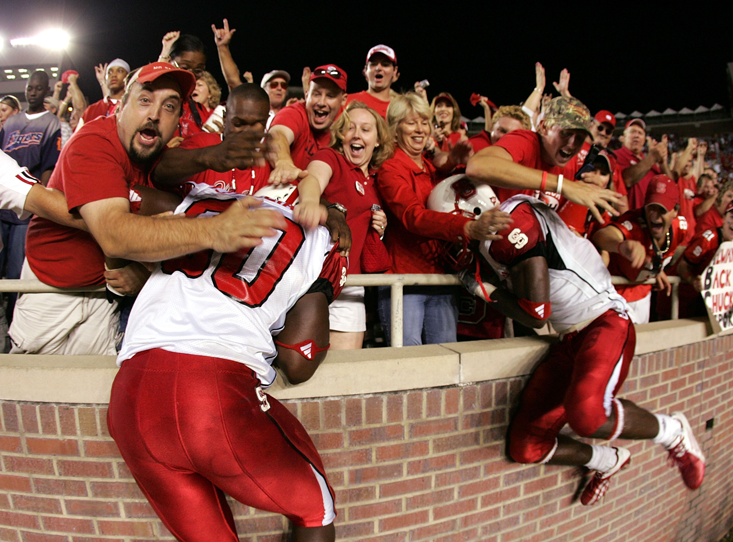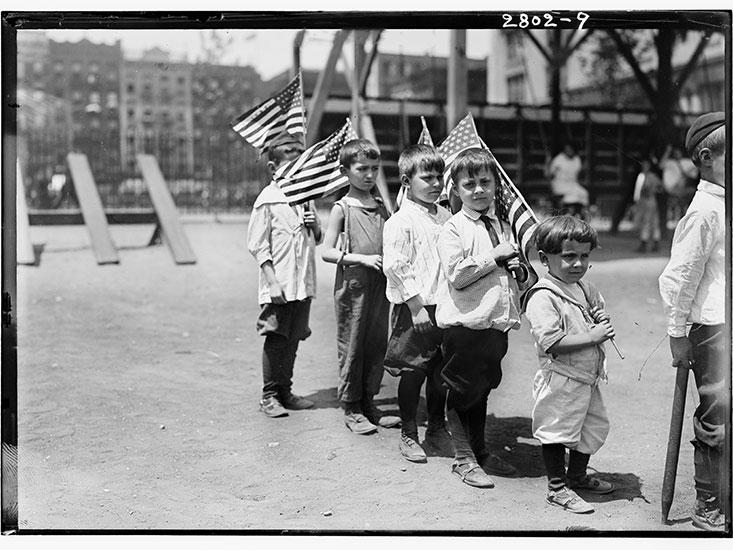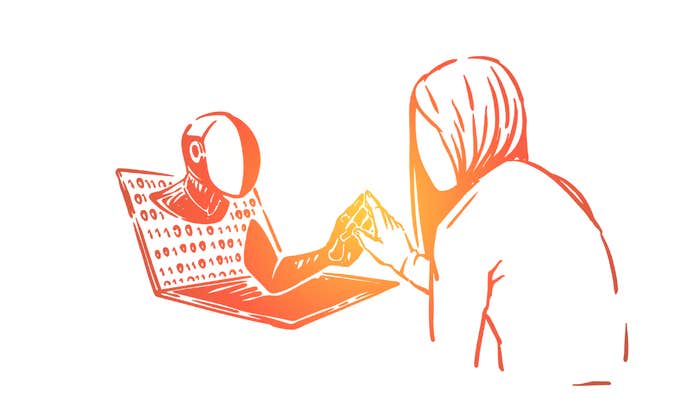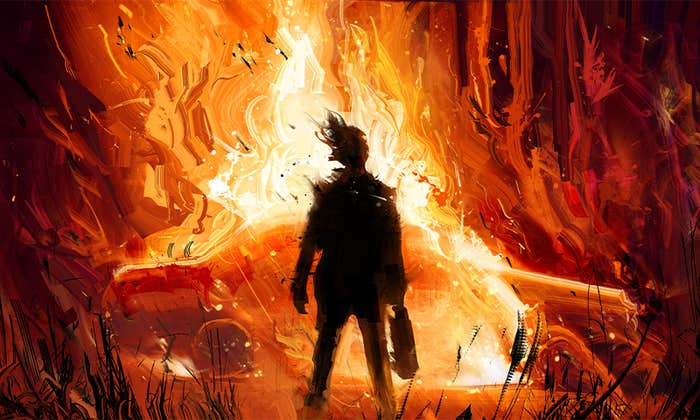It started with one man quietly sipping a Tom Collins in the lounge car of the Cleveland-bound train.
“God bless America,” he sang, “land that I love …”
It didn’t take long. Others joined in. “Stand beside her … and guide her …” Soon the entire train car had taken up the melody, belting out the patriotic song at the top of their lungs.
It was 1940 and such spontaneous outpourings, this one described in a letter to the song’s creator Irving Berlin, were not unusual. That was the year the simple, 32-bar arrangement was somehow absorbed into the fabric of American culture, finding its way into American Legion halls, churches and synagogues, schools, and even a Louisville, Kentucky, insurance office, where the song reportedly sprang to the lips of the entire sales staff one day. The song has reemerged in times of national crisis or pride over and over, to be sung in ballparks, school assemblies, and on the steps of the United States Capitol after 9/11.
Berlin immigrated to the U.S. at age 5. His family fled Russia to escape a wave of murderous pogroms directed at Jews. His mother often murmured “God Bless America” as he was growing up. “And not casually, but with emotion which was almost exaltation,” Berlin later recalled.
“He always talked about it like a love song,” says Sheryl Kaskowitz, the author of God Bless America, the Surprising History of an Iconic Song. “It came from this really genuine love and a sense of gratitude to the U.S.”
To understand why patriotism is such a powerful tool in politics, start with ingroups and outgroups.
It might seem ironic that someone born in a foreign land would compose a song that so powerfully expressed a sense of national belonging—that this song embraced by an entire nation was the expression of love from an outsider for his adopted land. In the U.S., a nation of immigrants built on the prospect of renewal, it’s not the least bit surprising. It is somehow appropriate.
Patriotism is an innate human sentiment. It is part of a deeper subconscious drive toward group formation and allegiance. It operates as much in one nation under God as it does in a football stadium. Group bonding is in our evolutionary history, our nature. According to some recent studies, the factors that make us patriotic are in our very genes.
But this allegiance—this blurring of the lines between individual and group—has a closely related flipside; it’s not always a warm feeling of connection in the Cleveland-bound lounge car. Sometimes our instinct for group identification serves as a powerful wedge to single out those among us who are different. Sometimes what makes us feel connected is not a love of home and country but a common enemy.
That’s why politicians so often invoke patriotism to demonize the other side, subtly implying that those who aren’t with us, are against us. It’s a partisan strategy, as predictable every election year as campaign buttons and patriotic bunting. When we identify as “Americans,” or citizens of any country, there’s something about a perceived threat, or slight to our nation, that works just as powerfully as a beautiful song to turn what might seem an intellectual idea into something emotional, raw, and subconscious. The instincts that drive patriotism, scientists explain, can express humanity’s best side, and its worst.
In the 1970s, a British social psychologist named Henri Tajfel assigned student volunteers to two random groups—although that’s not what he told the students. He informed them they had earned group membership based on specific criteria. The criteria were arbitrary and trivial—as trivial as the experimenters could come up with. Some groups were delineated by a preference for abstract art, others by their ability to estimate the number of dots in a picture.
Yet even when participants in the different groups knew members of the other group beforehand—and even when they had had no face-to-face interaction with their own group members—the experimental subjects consistently behaved the same: When given the option, they discriminated against those in other groups and acted in ways that benefited those in their groups. They did so even when it brought no concrete benefit to them.
Tajfel called the group with which individuals identified the “ingroup,” and the group of others the “outgroup.” These terms became a staple of psychology, and now neuroscientific and genetic research.
If you are group-oriented, you prefer to be around people like you. But you are less open to new experiences.
To understand why patriotism is such a powerful tool in political campaigns, why patriotic symbols are so potent, a good place to start is with ingroups and outgroups, say those who study the phenomenon. Ingroups and outgroups can help explain the roots of prejudice, of school pride—and even why some people wear Styrofoam hats made to resemble cheese, or paint themselves the color of their favorite football team and scream bare-chested from the sidelines every time someone is tackled.

The work of Tajfel suggests that the groups we identify with provide an essential sense of identity and belonging. Just as we intuitively categorize objects, using language to structure our understanding of the world, social groups help us make sense of the world, and our place in it. Once we have identified our place in the world, we are motivated to enhance the status of these groups as a way of enhancing our self-esteem—or, conversely—by convincing ourselves that our group is better than others.
“Patriotism is a form of identity,” says Jay Van Bavel, a social psychologist at New York University. “Obviously there is a difference depending on where you go in the world, and the specific cultural values associated with that identity. But a lot of psychology and neuroscience is built on the same principals of identity, whether it’s our identity as Yankees fans or members of a pick-up game of basketball at the local gym, or our identity as Democrats or Republicans.”
With the advent of brain scanning technologies and modern genetics, scientists have spotted the immensely powerful psychological alchemy that goes on just below the surface of our consciousness. These studies demonstrate that group identification is both innate and almost immediate.
For a recent experiment, Van Bavel and collaborators took a page from Tajfel and randomly assigned volunteers to one of two groups. Then they asked those volunteers to climb into an fMRI machine and view images of ingroup and outgroup members. When shown pictures of members of their group, the subjects demonstrated greater activation in the amygdala, an ancient brain structure associated with emotional valence, than when presented with nonmembers. Like Tajfel’s early experiments, this occurred even when group categories were entirely arbitrary and had been assigned just minutes before.
Van Bavel also found participants, when viewing ingroup members, experience heightened activity in the fusiform face area of the visual cortex—a special area for identifying faces—and also in the ventral medial frontal cortex, an area thought to play a key role in assigning value. These responses were remarkably immediate: Show someone pictures of people and you can often guess who is in the ingroup and who is in the outgroup just by studying the brain activation patterns.
“What groups do is confer value,” Van Bavel says. “The moment you are part of a group you are more likely to value fellow group members, and you’re more likely to value symbols associated with the group, like the flag.” Van Bavel has begun to uncover evidence that the reward centers of the brain light up when subjects see a group member receive a reward, like money, even if they experience no reward themselves.
Other work suggests these tendencies—this blurring of the lines between self and other, a feeling that benefits to the group are benefits to the individual—are innate, perhaps even honed on the crucible of natural selection.
Stephanie Preston, a psychology professor at the University of Michigan, notes that insights can be drawn about innate group responses throughout the animal kingdom. To understand human behavior, she has studied wolf packs, tribes of chimpanzees, sled dogs, even fish. One common characteristic is that emotions appear to be contagious, and in a group setting can spread rapidly.
“In captive colonies, you can easily observe when one animal gets upset, they all get upset,” Preston says. “If one starts screaming they all start screaming, even if only one has been injured in attack.” Patriotism, she notes, can involve this sense in which emotion and importance are elevated in a group setting.
Preston explains people identify more deeply with those in their ingroup than those who are not. “We know people have greater empathy and greater tendency to mimic ingroup members,” she says. That can be explained by what she calls a “perception action model,” a shared emotional experience occurring when one person feels a similar emotion to another as a result of perceiving the other’s state. It’s a neural process, she says, in which “you map other people onto your own body state, and it’s easier to do that with people who are more similar in identity, age, or gender.”
Conversely, xenophobia can be attributed to a “dissimilarity in perception,” Preston says. “People from other races, or nations, are slightly more difficult to map onto our neural substrates.” And that, in short, creates an empathy gap.
Psychologists have spotted a distinction between the ways that people identify with groups. Mina Cikara, a psychologist who runs the Harvard Intergroup Neuroscience Lab, says there is an important distinction between patriotism and nationalism. Patriotism, she notes, is “ingroup love”: We sacrifice out of love for the greater good. Nationalism is about “outgroup hate”: We punish those not like us.
“Nationalism is more like ‘We’re better than everybody else,’ as opposed to patriotism, which is ‘We’re great,’ ” Cikara says. “One is just really about being prideful of your group, and the other is about being oriented specifically toward superiority over other countries. That’s why people think nationalism is gross and typically associate it with Nazi Germany. Whereas patriotism is something everyone should possess as a virtue.”
Some scientists have even begun to demonstrate we might have a genetic tendency to experience patriotism or nationalism, and that different genes might predispose us to those sentiments. “Genes are built-in personality dispositions—abstract ways of engaging with the world,” says Gary Lewis, a lecturer in the Department of Psychology at the University of York, and the Department of Twin Research and Genetic Epidemiology at Kings College, London. Lewis compared the attitudes of 452 pairs of German monozygotic (identical) twins, who shared 100 percent of the same DNA, 336 dizygotic (fraternal) twins who share 50 percent of the same DNA, and 87 unmatched twins reared together. Since both members in each of the pairs had been raised in the same environment, the study design allowed Lewis to look at the role of genetics in producing differences, largely ruling out environmental factors.
A sense of weakness and anxiety lead us to depend on the group, to run to the group for cover.
In one 2014 study, Lewis specifically examined patriotism, nationalism, and prejudice and attempted to quantify genetic influence. To gauge patriotism, Lewis and his team asked the twins to rate their level of agreement on four questions, including ‘‘I love Germany.” To measure nationalism, they included questions such as ‘‘People who do not dearly support Germany and do not respect the culture should live somewhere else.”
The evidence was clear: Identical twins were far more likely to have identical attitudes than fraternal twins. He concluded 50 percent of the variation within a culturally similar group of individuals can be attributed to genetic factors. It was a mathematical analysis so Lewis could only quantify correlations between answers—but he was able to demonstrate that the connection between patriotism and nationalism was not particularly strong.
Lewis found a negative correlation between both traditionalism and ingroup favoritism and a psychological trait called “openness,” which refers to a willingness to explore new foods, and new places, and seek out new experiences.
“The genetics that make you lower in openness are the genetics that seem to make you more predisposed to group favoritism,” Lewis says. “If you are very group-oriented, you prefer to be around people like you. But you are less open to new experiences.”
In her studies, however, Harvard’s Cikara and others have found that it is possible to transform ingroup love into outgroup hate—if we perceive an outside group as threatening.
Many researchers have demonstrated this, she notes, by splitting people into groups in the lab, endowing them with money, and offering them several options. To measure group love and willingness to sacrifice, individuals are told they can either keep the money for themselves or invest it in a group pot. Whatever money they put toward the group will be multiplied by some number and then given back to everybody. This demonstrates self-sacrifice because the money that the subjects personally will get back when they invest in the group pot will be less than they put into the pot. However, the group as a whole will get richer.
It turns out, we may be hardwired to put the needs of the group first: “What researchers find is that on average most people keep a little bit of money or give all of their money to the ingroup pot.”
This is not the case with outgroup dislike. To measure outgroup dislike, subjects are sometimes offered a third option: They can invest some of their money in “an outgroup hate pot.” Whatever money is put in the hate pot gets multiplied and then subtracted from the other group’s funds. Subjects who put money in the hate part are paying to punish people in another group. Under normal circumstances, Cikara says, “very few people actually go out of their way to try to harm the outgroup.” Our default seems to be “live and let live.”

However, in recent years, Cikara has made an active effort to study what factors might cause that to change.
Perhaps not surprisingly, she found that the willingness to sacrifice money to punish an outgroup rose when subjects were made to feel that an outgroup posed an active threat to the needs of the ingroup. But what was, perhaps, more telling was what the underlying brain data revealed: When an outgroup was seen as a threat to the ingroup, failure and punishment of the outgroup caused areas of the brain related to feelings of reward to light up. Her research on baseball fans is perhaps most instructive.
Cikara demonstrated this, perhaps most convincingly, by monitoring the brain activation patterns of Red Sox and Yankees fans. “We wanted to see whether there were reward-related activations consistent with people’s self-report of pleasure,” she says. “And indeed there was when they watched their team’s rivals fail, including when they watched their rival fail against the Orioles. So it’s not just from watching the success of your own team. It’s really just watching your outgroup suck.”
Brain scans showed Red Sox fans took almost sadistic pleasure in watching the Yankees lose, even when the Red Sox were not the opposing team. The Red Sox fans did not demonstrate similar reactions when the Orioles fared badly against another team. The outgroup really has to be “reviled” in order to get people to do more than just love the ingroup, she notes.
“In most of our groups, we just care about our ingroup and we’re free to ignore everybody else because they don’t pose an active threat,” Cikara says. “However, there are some outgroups to which we have to pay attention because they have significant consequences for our own group. All teams are technically competitors but they don’t have that same quality. And it’s because the other team poses an active threat. Or there’s a long history of rivalry and not liking each other.”
This takes on real-world consequences when you consider the lasting legacy of competition and warfare between Serbs and Croats, for instance, or Sunni and Shia in the Middle East. Or Tutsi and Hutus in Rwanda. Solidarity with an ingroup and hatred of an outgroup, molded by history, culture, and perceptions rooted in subconscious forces, can explain the horrific actions of terrorists.
What psychological factors govern group identification? In particular, what factors drive outgroup hatred? Arie W. Kruglanski, a social psychologist and distinguished professor of psychology at the University of Maryland, has been exploring the questions.
“Identification with a group prolongs your individual existence because the group has a transcendental existence beyond the existence of any of its individual members,” Kruglanski says. “Once you feel part of the group you are less afraid of death because as a member of the group you acquire a kind of immortality. So it feels very good to be a member of the group, to be part of the collective.”
Kruglanski has conducted research in Pakistan, Egypt, and Indonesia, among other places, and found a correlation between the degree to which individuals feel they are failing in their personal pursuits and the extent to which they identify strongly with their nation or religion. He argues the tendency to be group-oriented and identify with a group is strengthened when we “cannot very well hack it as individuals.” He adds, “A sense of weakness and anxiety lead us to depend on the group, to run to the group for cover, in the same way as a threat prompts little children to run to their mothers and fathers for cover.”
Kruglanski pioneered a theory he calls “cognitive closure,” which he equates with an innate need for a feeling of certainty and consistency about the world around you. It’s a research thread that has led him inevitably to the study of groups, and in particular extreme patriotism and nationalism.
“There’s an intimate connection between a need for closure and group identification, including patriotism,” he says. “Once you become uncertain about your own self, you seek certainty, and that certainty is afforded by the group ideology that tells you who you are. You are a member of this group and you adopt the group ideology.”
Failure, he argues, introduces the need for closure because failure threatens one’s self concept. When one feels discriminated against, it can introduce uncertainty about the self and “embracement of a group ideology that tends to be extreme—more holy than the Pope,” Kruglanski says.
“There is ample evidence that failure leads to a tendency to embrace the group, to embrace one’s social identity. Especially if that social identity promises one empowerment and respect. The fact that you are a member of a larger entity is very protective. You are under the shelter of a more powerful transcendental entity and you do not have to worry about your own personal individual failures and anxieties.”
Kruglanski’s research has shown that individuals become disillusioned with groups that don’t seem to respect them, or have relegated them to a lower level of citizenship. This can cause them to identify with a new group. Conversely, he has found evidence that individual success tends to lead people away from collectivist identification.
“If you are successful as an individual, you feel less dependent on the group,” Kruglanski says. “Children who feel empowered and encouraged venture to explore the environment. Individuals who feel successful and competent and independent release the bond they have with the group. They become individualistic.”
For immigrants like Irving Berlin, patriotism was a bond to the country that welcomed them. Tolerance, openness, and empathy arise from deep in human nature. They are part of us. Patriotism divides us rather than unites us when we lose sight of who we are.
Adam Piore is a freelance writer. His previous Nautilus articles include “What Technology Can’t Change About Happiness” and “Why We Keep Playing the Lottery.” @adampiore



























